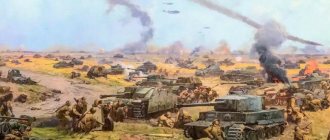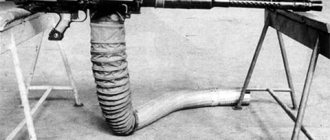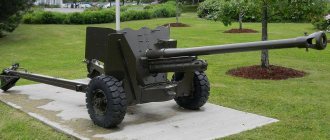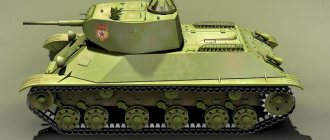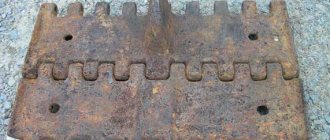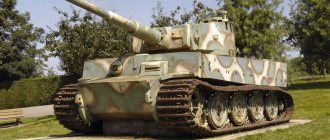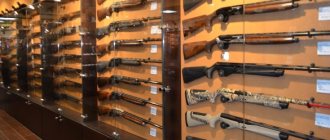On the irretrievable losses of armored vehicles of the USSR and Germany in 1943
Why the T-34 lost to the PzKpfw III, but won against the Tigers and Panthers.
Studying the statistics of losses of armored vehicles of Germany and the USSR in the Great Patriotic War, we see that it is completely impossible to compare them head-on, since the concept of “irretrievable losses” was understood differently by both the Red Army and the Wehrmacht.
But this is not the only problem - in the previous article, the author showed another reason that irretrievable losses of armored vehicles cannot serve as a measurement of the combat skills of the parties. The fact is that in 1943, Soviet tanks and self-propelled guns received critical damage, excluding the repair of damaged armored vehicles 1.5-2, and possibly more, times more often than their German opponents. As an analysis of German losses on the Kursk Bulge shows, their level of irretrievable losses was 20, maximum 30% of the total losses of armored vehicles, and for Soviet tanks and self-propelled guns it reached an average of 44%, but could be even higher. What did this mean? Roughly speaking, in order for the Germans to completely destroy 40 Soviet tanks, they had to knock out 100 of these combat vehicles in battle, but in order for our soldiers to irrevocably destroy 40 German tanks, they had to knock out 150-200 or more.
Why did this happen?
The first reason is very simple.
The Germans in 1943 attached great importance to the destruction of disabled enemy armored vehicles. That is, it was not enough for them to knock out a Soviet tank - they also needed to make sure that it received damage that was completely incompatible with further combat activity. If they doubted that the equipment had received such damage, the tank crews or sappers blew it up. The Germans put this activity on stream. Ours, although they were doing the same thing, there is a strong feeling that they did not make as much effort as the Germans to remove previously destroyed German armored vehicles. However, the author does not have exact figures on this issue.
The second reason is also the main one
It lies (you will laugh now) in the weakness of the armor protection of German tanks.
Yes, yes, you heard right: it is very likely that it was the weakness of the armor that reduced the level of irretrievable losses of German armored vehicles! How so? And it's very simple. In previous articles we looked in great detail at the evolution of German anti-tank artillery in 1942. Faced with Soviet T-34 and KV tanks, the Germans were forced to quickly stock their battle formations with specialized 75 mm anti-tank guns, both towed (Pak 40) and and installed on equally specialized anti-tank self-propelled guns (“Marder”, etc.). But even this seemed not enough to them. The Wehrmacht had self-propelled guns, the main task of which was to support infantry units and which were armed with a short-barreled 75-mm gun (StuG), which was very unsuitable for fighting enemy armored vehicles - they were redesigned for a long-barreled 75-mm gun, thus adding anti-tank self-propelled guns to the usual ones possibilities. In addition, the new German tanks also received similar 75 mm guns.
And if during 1942 the Germans had to resort to various kinds of ersatz, such as the massive use of French 75-mm captured guns and (in much smaller quantities) domestic F-22s, which were still not created as specialized anti-tank guns, then During 1943, this deficiency was completely eradicated. If in 1942 the Wehrmacht and SS units received 2,144 units. Pak 40 and 2,854 French guns mounted on a German carriage and named Pak 97/40, then in 1943 the number of Pak 40 transferred to the troops had already reached 8,740 units. At the same time, the production of anti-tank guns of smaller calibers was curtailed in 1943 - if in 1942 4,480 units were produced. a very good long-barreled 50-mm Pak 38, then in 1943 only 2,626 units were created, and then their production was completely stopped. There was also no mass use of captured equipment.
Therefore, in general, it can be stated that in 1943, the German anti-tank defense was built on a specialized and very powerful 75-mm artillery system, capable of successfully fighting our T-34 and KV. But this, of course, is not all.
In 1943, the massive use of a new type of German tank began: we are, of course, talking about the “products” TV “Panther” and T-VI “Tiger”. It must be said that until this time both the Red Army and the Wehrmacht possessed extremely powerful weapons capable of destroying almost any enemy tank at a direct shot range, and even beyond. We are, of course, talking about the famous German 88-mm and somewhat lesser-known, but also extremely powerful domestic 85-mm anti-aircraft guns.
Both of them had a sufficient level of armor penetration and projectile power to combat enemy armored vehicles, but there were important factors limiting their use. Firstly, these were anti-aircraft guns, which were needed to counter enemy aircraft, and diverting them to destroy enemy tanks meant weakening the air defense in favor of the anti-aircraft guns - and this was not always acceptable. Secondly, such guns were too expensive to create anti-tank guns on their basis, and there was no need for this, since even the most powerfully armored Soviet vehicles could be dealt with by smaller-caliber artillery. You need to understand that even the industrial power of Germany could not ensure the production of 88-mm “Acht-Koma-Aht” in volumes that met the air defense needs of the troops and the country. Thirdly, the requirements for anti-aircraft and anti-tank guns are fundamentally different in many ways. So, for example, an anti-tank gun should be made as low and inconspicuous as possible. And, since its main combat distance does not exceed the range of a direct shot, the anti-tank gun does not require a large elevation angle, which makes it possible to get by with a low carriage. For an anti-aircraft gun, the opposite is true: the elevation angle should be 90 degrees, which is why a high carriage is needed. In addition, an anti-aircraft gun definitely needs all-round fire, and it must turn quickly, there is no time to pull the coulters out of the ground and deploy the gun while firing at enemy aircraft. For an anti-tank gun, such a skill will also, in general, not be superfluous, but it can be neglected. But for an anti-aircraft gun, size and weight are extremely important, since in battle it is very important that the crew can roll it on their own, but for an anti-aircraft gun this is absolutely not necessary, etc.
As a result, anti-aircraft guns, of course, were a formidable, but very situational anti-tank weapon. Finding themselves in the right place at the right time, anti-aircraft guns could stop almost as many enemy tanks as there were shells in their ammunition, but at the same time, after discovering their positions, they became very vulnerable to enemy field artillery, and due to their large dimensions and weight, they were not could quickly change position.
Understanding the shortcomings of the 88-mm anti-aircraft gun as an anti-tank weapon, the Germans tried to solve the issue radically. Simply put, they put this, in every respect, outstanding artillery system on tracks protected on all sides by 100 mm of armor, which provided it with both the necessary mobility and almost ultimate protection from field and anti-tank artillery.
This is how, in fact, the T-VI “Tiger” tank turned out, which, with all its many shortcomings and in those cases when it was still possible to deliver it to the battlefield in a timely manner, was an ideal anti-tank weapon in less than five minutes. In total, the Germans produced 643 such machines in 1943. But that’s not all - in 1943, the specialized anti-tank towed 88-mm gun Pak 43 and Pak 43/41, which differed from the Pak 43 in the use of a classic carriage from a 105-mm gun, also began to enter service.
In the photo - Pak 43/41 in the foreground, Pak 43 in the background
Being a perfect “tank killer”, the “Tiger”, due to its large mass, huge fuel consumption and other operational characteristics, was completely unsuitable for use as the main combat vehicle for tank divisions. In this role, the Germans intended to use the Panther T-V, which was a creative rethinking of the ideas contained in the T-34. We will look at the technical characteristics of this outstanding brainchild of the German tank industry later, but for now we will focus only on its main armament: the 75-mm KwK 42 gun.
Before its appearance, the 75-mm KwK 40 with a barrel length of 43 and 48 calibers was widely installed on German armored vehicles. The speed of the caliber armor-piercing projectile of these guns was 770 and 792 m/sec, respectively, which was quite enough to confidently destroy the T-34 even in the frontal projection at a distance of up to 1000 m, however, the frontal part of the hull reliably penetrated only 500, perhaps 700 m. But the 75-mm KwK 42 installed on the Panther had a 70-caliber barrel and gave its caliber armor-piercing projectile an initial speed of 935 m/sec. Of course, the T-34’s armor did not protect at all from such attacks, and at a direct shot range the Soviet tank made its way into any projection: one could only count on a rebound, which was possible only under an extremely successful (for the T-34) combination of circumstances.
What does a “direct shot” have to do with it?
Perhaps the dear reader is already wondering why the author of this article constantly uses the phrase “direct shot range.”
The fact is that many military history buffs evaluate the range of a tank battle solely from the point of view of the armor penetration of the guns of the armored vehicles participating in it. That is, for example, if the table armor penetration of the KwK 42 was as much as 89 mm of homogeneous steel armor at a distance of 2 km, then the Panther could easily destroy the T-34 from a distance of 1.5-2 km. However, this approach is too one-sided, since it does not take into account the capabilities of the sighting devices of armored vehicles of that time. But it did not provide any reliable destruction of enemy tanks at such long distances. What is the range of a direct shot? This is the longest target range, when firing at which the average trajectory does not rise above the height of the target.
That is, with such shooting, in order to hit a target, you need to aim directly at the tank, at the hull or turret, depending on the range, but the point is that, by aiming the sight at an enemy vehicle, the artilleryman will hit it. But for firing at distances exceeding the range of a direct shot, it will be necessary to solve a geometric problem similar to the one calculated by naval gunners: determine the range and parameters of the target’s movement, calculate the necessary corrections, because even at a speed of 20 km/h the tank per second overcomes 5.5 m, etc. All this is complicated and reduces the likelihood of quickly hitting the target, while enemy tanks, even if taken by surprise, will naturally try to get out of the fire, so the anti-tank gun or tank unmasks its position in vain. Thus, the actual combat distances during the Great Patriotic War were significantly lower than the table armor penetration of German tanks allowed. As an example, consider the table given in the monograph by A. Shirokorad “God of War of the Third Reich”, dedicated, as one can easily guess, to German artillery of the corresponding period. The table was compiled based on studies of 735 damaged tanks and self-propelled guns: data from reports was taken, in most cases measurements were taken from the location of the damaged vehicle to the position of German tanks or anti-tank artillery.
The above data irrefutably demonstrates that in most cases, 75-mm German guns fought anti-tank battles at a distance of 400-600 m (33.5% of cases), and 88-mm - 600-800 m (31.2%). At the same time, 75-mm guns hit 69.6% of their targets at a distance from 100 to 600 m and 84.1% from 100 to 800 m, and 88-mm guns hit 67.2% at a distance from 100 to 800 m and 80 .7% - at a distance from 100 to 1000 m.
Unfortunately, the fact that actual combat distances were significantly lower than those that theoretically provided armor penetration for the gun is very often forgotten, and this leads to completely wrong conclusions. A simple example: as we said earlier, the 75-mm T-IVH cannon penetrated the frontal armor of the T-34, with the exception of the frontal part at a distance of 1,000, and according to some reports, even 1,200 m, and the frontal part could penetrate from 500 meters -700. A Soviet tank, although it could pierce the frontal armor of the turret with a caliber solid armor-piercing projectile at a distance of about 1000 m, could pierce the 80 mm frontal parts of the hull only with a sub-caliber projectile and only from a distance of no more than 500 m or even less.
It seems that this gives the German tank a stunning advantage in the event of a head-to-head duel. But if we assume, based on the statistics presented above, that almost 70% of such duels took place at a distance of up to 600 m, and in 36.1% of cases the tanks fought at a distance not exceeding 400 m, then we understand that in such, In general, in a tactical situation unfavorable for the T-34, the superiority of the German tank is not at all as great as it might seem based on the armor penetration tables. And one more thing - it becomes clear how important the height of the tank is, because the higher the tank, the further the distance of a direct shot at it: the same American Shermans could hit German anti-tank tanks from a greater distance than the T-34.
Does all of the above mean that the German designers were wrong in their desire to provide the Panzerwaffe with extremely powerful 75-88 mm guns? Yes, nothing happened. Firstly, a more powerful weapon has a flatter trajectory of ammunition, which means a longer direct shot range than a less powerful one. And secondly, at relatively short distances - up to 600 m for 75-mm guns and up to 1,000 m for 88-mm guns, these artillery systems with the highest probability ensured a breakdown of the armor of the same T-34 and the rupture of an armor-piercing projectile in the armored space.
Brief conclusions on the Wehrmacht VET in 1943
So, let’s briefly summarize the main trends in German anti-tank guns and tank guns in 1943. The German army rearmed itself with long-barreled 75-88 mm anti-tank guns, and this applied to both towed artillery and tanks and self-propelled guns, while continuing to widely use anti-tank guns as weapons. 88-mm anti-aircraft “aht-koma-aht”.
The consequences were not long in coming. If before September 1942, 75-mm artillery accounted for only 10.1% of all damage inflicted on Soviet tanks, and for 88-mm guns this figure was a vanishingly small 3.4%, and more than 60% of all damage caused 50- mm guns, then in the Stalingrad operation the percentage of damage caused by 75 mm and 88 mm guns was already 12.1 and 7.8%, respectively. But in the Oryol offensive operation, 40.5% of all damage was caused by 75-mm caliber guns, and another 26% by 88-mm caliber guns, that is, in total, artillery systems of these calibers accounted for 66.5% of the defeats of Soviet tanks! In other words, in 1942 and earlier, the main means of anti-tank weapons in the Wehrmacht were guns with a caliber of 50 mm or less, and in 1943 - 75-88 mm. Accordingly, the number of through holes in the armor protection of Soviet tanks increased: until September 1942, the share of such holes was 46% of their total number (in addition to through holes, there were also non-through holes), in the Stalingrad operation they already accounted for 55% of all defeats, and in the Oryol operation offensive operation reached 88%!
And so it turned out that in 1943, our tank units were obviously faced with a sharp increase in irretrievable losses, because the bulk of enemy hits came from 75-88 mm shells, which pierced the armor of the T-34 and KV and exploded in the armored space. The rupture of such a shell in the ammunition load or in the fuel tank practically guaranteed the destruction of the “thirty-four”, without the slightest chance of its restoration: the explosion of the ammunition load destroyed the vehicle completely, and burnt vehicles in 87-89% of cases could not be restored. But even if nothing like that happened, a relatively heavy German shell could still completely destroy a domestic tank - and, alas, it did.
What about our VET?
She, alas, turned out to be “corrupted” by the weakness of the protection of German tanks. In conditions when the armor protection of the bulk of the German “threes” and “fours” even in 1942 did not exceed 30-50 mm, even the famous “forty-five” - a 45-mm anti-tank gun mod. 1937 with a barrel length of 46 calibers.
However, 40-50 mm of armor already presented some problem for it, so in 1942 an improved model of the “forty-five” with a barrel 68.6 calibers long was developed - we are talking about the M-42.
This artillery system accelerated a caliber armor-piercing projectile weighing 1.43 kg to a speed of 870 m/sec, which was 110 m/sec more than that of the mod. 1937. In terms of its combat capabilities, the M-42 was quite close to the capabilities of the German 50-mm Pak 38 (if you do not take into account the quality of the shells), but there is a nuance - the M-42 went into production in 1943, that is, right then , when the Pak 38 was discontinued.
In general, of course, the M-42 was a fairly formidable anti-tank weapon due to its low weight and size, comparative low cost of production, and most importantly, due to the outright weakness of the side armor of the German T-III and T-IV tanks, which usually did not exceed 30 mm. It was easy to hide the M-42 by positioning the batteries so that they covered each other with crossfire, so that the Germans had no way to stand in front of them. But it cannot be said that we had so many of these guns in 1943 - in total 4,151 units were produced during that year.
A remarkable anti-tank gun was the 57-mm gun mod. 1941 ZiS-2, firing a 3.19 kg caliber projectile with an initial speed of 990 m/sec.
Such ammunition could easily hit 80-mm T-IVH armor plates head-on at a distance of about 500 m; the ZiS-2 could easily withstand even Tiger tanks. But truly mass production of the ZiS-2 was never established during the war years - in 1941, only 141 guns were produced, and then they were taken out of production until 1943. But even in 1943, only 1,855 were transferred to the troops. such guns: it must be said that the ZiS-2 was completely late for the Kursk Bulge, since of all the troops that the Red Army managed to concentrate there, only 4 anti-tank fighter regiments were armed with them.
Thus, the brunt of anti-tank battles continued to be borne by the “jack of all trades” 76.2 mm ZiS-3, the production of which in 1943 amounted to as many as 13,924 units.
But for all its undeniable advantages, this artillery system was in no way a specialized anti-tank weapon. The ZiS-3 gave its caliber armor-piercing projectile an initial speed of only 655 m/sec, which was more or less enough for the bulk of German armored vehicles in 1942, but was no longer very good for 1943.
And what else? Of course, there was an excellent 85-mm anti-aircraft gun 52-K, capable of confidently hitting German tanks at a direct shot range, but there were few of these guns - for all the years of production, from 1939 to 1945, 14,422 of them were produced, and in Our air defense desperately needed them.
As for domestic armored vehicles, the bulk of Soviet tanks produced in 1943 were armed with 45-mm or 76.2-mm F-34 cannons, the latter being approximately equivalent in its anti-tank capabilities to the ZiS-3. As for the self-propelled guns, the bulk of them consisted of the light SU-76, still with the same 76.2-mm cannon, and the SU-122, which was armed with a 122-mm short-barreled howitzer with a barrel length of 22.7 calibers.
By the way, very high hopes were pinned on the latter specifically in terms of anti-tank warfare, since it was assumed that their cumulative shells would become a very formidable weapon. The shells turned out to be formidable, but it quickly became clear that due to the “mortar” ballistics of the 122-mm howitzer, it was very difficult to hit an enemy tank with it. Our tank crews began receiving specialized anti-tank self-propelled guns only in August 1943; they simply did not have time to significantly influence the outcome of this year’s battles. Of course, if you look at the time of production, it seems to be working out well: from August to December 1943, 756 SU-85s were produced.
But new equipment did not appear on the battlefield immediately after release - it had to enter the troops, who had to learn how to use it, etc. Therefore, for example, the German “Panthers,” although they had been produced since February 1943, only went into battle near Kursk, in July. And the same applies to the only real “opponent” capable of resisting the new Wehrmacht tanks in 1943 - the SU-152. In February-June 1943, 290 such self-propelled guns were produced, but only 24 of these vehicles reached the Kursk Bulge. In total, 668 units were produced for our troops in 1943. SU-152 and 35 more units. ISU-152.
At the same time, of course, you need to understand that “the ability to hit an enemy tank” is one thing, but “an effective anti-tank weapon” is a little different. Yes, the SU-152 had a very powerful 152-mm howitzer-cannon ML-20S, whose armor-piercing projectile had an initial speed of 600 m/sec and a mass of 46.5-48.8 kg. However, the mass of the projectile and the associated separate loading made this artillery system not fast enough for tank combat - only 1-2 rounds/min. Therefore, we can say that the SU-152, although it had greater versatility compared to the Wehrmacht self-propelled guns that were armed with 88-mm guns, since it coped better with the destruction of field fortifications, etc., was still inferior to them as a "tank destroyer".
In other words, the Red Army, unlike the Wehrmacht, was late in deploying specialized high-power anti-tank guns, and this happened due to the relatively weak armor of German equipment, since before 1943 there was simply no particular need for them. Alas, when this need was realized, rearmament could not be carried out at once. And the consequence of this was that in 1943 the main burden of the fight against fascist armored vehicles fell on the old and modernized “forty-fives”, and on universal guns with a caliber of 76.2 mm F-34 and ZiS-3. At the same time, our guns also had problems with the quality of armor-piercing shells, as a result of which, for 76.2-mm artillery systems, the industry was forced to switch to the production of 53-BR-350SP steel blanks, which, although they had acceptable armor penetration, were not were carrying explosives.
That is, at a time when the German anti-tank missile defense provided armor penetration and rupture of shells with a caliber of 75 mm or more inside the domestic tank, the domestic anti-tank missile system fought either with a 45-mm projectile, quite capable of penetrating 25-30 mm of the sides of “threes” and “fours” and disable them, but at the same time having a low armor effect, or with 76.2-mm monolithic blanks or sub-caliber projectiles, whose armor effect was also low. Such shells, of course, could also disable an enemy tank, but they, with rare exceptions, destroyed its individual components and assemblies, but could not destroy the tank or self-propelled guns completely.
In other words, the main reason for the relatively high level of irretrievable losses of tanks and self-propelled guns of the USSR in 1943 compared to German tanks was the lack of specialized anti-tank guns capable of turning enemy tanks into a pile of scrap metal with 1-2 hits. The Soviet anti-tank missile system, oddly enough, even in these conditions coped with its duties very well, its hits disabled enemy tanks and self-propelled guns - but the problem was that due to the relatively weak armor effect of domestic shells, most of the damaged equipment could be destroyed. was put into operation. At the same time, the German 75-88 mm artillery systems left the same “thirty-fours” much less chance for a “second life after overhaul.”
And finally, the last thing. At the beginning of 1943, the Germans practically excluded light armored vehicles from their battle formations - their TI, T-II and other Czech models accounted for just over 16% of the total number of tanks and self-propelled guns - out of 7,927 tanks and self-propelled guns with which the Wehrmacht met the new, 1943, there were only 1,284 of them. At the same time, the share of light armored vehicles in the tank forces of the Red Army as of 01/01/1943 was 53.4% - out of 20.6 thousand tanks of the USSR, 11 thousand were light. In addition, the production of light equipment in the USSR continued in 1943, while in Germany the production of such tanks was completely curtailed.
Thus, we see that there were a lot of objective reasons why the irretrievable losses of tanks and self-propelled guns of the USSR should have significantly exceeded the German ones in 1943. And they were completely unrelated to the martial art of the Red Army and the qualities of Soviet tankers. In order to compare the level of combat training of the tank troops of the Wehrmacht and the Red Army, it is necessary to compare the total, that is, returnable and irretrievable losses of armored vehicles of the parties, but this analysis cannot be done due to the lack of reliable data from the German side. And comparing only irretrievable losses is completely meaningless, since for the reasons stated above, out of 100 destroyed German tanks, the Germans irretrievably lost 20-30 vehicles, and ours lost 44 or more.
But the essence of the matter is that both sides in our example, as a result of the battles, lost exactly 100 tanks destroyed, and not 20-30 or 44. And as a result of this simple arithmetic, the German tank divisions, having irretrievably lost only some 15-20% of the initial combat personnel found themselves with 10-20 combat-ready vehicles in front of the steel roller of the Red Army rolling on them. And, of course, they could no longer help their infantry and other units.
And then, after the war, the same E. von Manstein, describing his “victories” on the Kursk Bulge and the “successful” retreat of the troops entrusted to him, during which they, of course, not only fully retained their combat capability, but also defeated many times superior forces. , the “hordes of the Red Army” pressing on them, literally a few pages later, he is forced, reluctantly, to describe the real state of the troops he had withdrawn to the Dnieper:
“In this regard, the group’s headquarters reported that in the three remaining armies it had, taking into account the arrival of three divisions still on the march, it had directly for the defense of the Dnieper line, 700 km long, a total of 37 infantry divisions (another 5 divisions that had lost their combat capability , were distributed among the remaining divisions). Thus, each division had to defend a strip 20 km wide. The average strength of first-echelon divisions is, however, currently only 1000 people
... ... Regarding the 17 tank and motorized divisions that the army group now has, the report indicated that none of them has full combat capability. The number of tanks has decreased as much as the number of tanks has decreased.”
And these words of the German field marshal are a real indicator of how the Red Army fought in 1943.
To be continued…
How many people were drafted into the Red Army?
Participation in the war He was drafted into the ranks of the Red Army
1 million 200 thousand people.
Interesting materials:
Is the consent of one of the parents required for a child to travel around Russia? Do I need to apply for permanent residence in Russia from Kazakhstan? Where does the supply of bananas to Russia come from? Where did Russia start? Where did Russia come from? Where do bananas come from in Russia? Where does the Russian Day holiday come from? Where do feijoas come from to Russia? Where are the gypsies in Russia from? Where do most immigrants come to Russia from?
Combat readiness on the eve of the collapse of the USSR
Foreign researchers assess the potential of the Union troops immediately before the end of its existence as very high. However, this was a heavy burden for the state, since due to the fall in oil and gas prices in the 80s, the country's economic opportunities fell sharply.
Gorbachev reduced the number of troops by 500 thousand people, and under him the “optimization” of various units began
. He withdrew troops not only from Afghanistan, but also from Germany, Czechoslovakia and other countries, and reduced his presence in Mongolia. During these years, combat effectiveness dropped to its minimum. On the one hand, this had a good effect on the economy (it should have!), on the other hand, it exacerbated the internal contradictions of the Union.
All ethnic conflicts of the post-USSR, including the recent Nagorno-Karabakh crisis, come from those times
. Yeltsin boasted that his wise policies made it possible to avoid internal war after the “divorce” of the socialist bloc, but he was disingenuous. There were clashes and in some places they continue to this day. But there were still no prerequisites or means for a mass war. It's unlikely they will appear.
Confrontation with NATO
The North Atlantic Alliance was created on April 4, 1949
. And 4 years have not passed since the largest conflict in the history of the earth, and humanity was again preparing for a global war. The creation of NATO is a powerful move on the part of the United States. Before this, the USSR had to confront only America, and after that - the entire Western world.
As a result, the Union’s potential began to be compared not with a specific country, but with NATO as a whole. The “Warsaw Pact” was essentially based on the resources of the USSR, and in addition to developing its army, the state had to equip other countries. The deployment of Soviet nuclear missiles in Cuba in 1962 is from the same series.
On the one hand, the confrontation with NATO led to an unprecedented development of the military industry in the USSR. Among the achievements are military space technology, nuclear weapons, and military shipbuilding. The Union built 4 heavy nuclear cruisers: Frunze, Kirov, Pyotr Velikiy, Admiral Nakhimov.
However, the high pace of confrontation depleted the USSR economy
. Yes, there was always money for the army, which cannot be said about civilian needs. The shortage of goods and their low quality irritated the population. Looking at the huge injections into combat capability, citizens were disappointed. From those times came the joke about attacking the United States and immediately surrendering. Of course, it reflects the sentiments of only a part of citizens, but it is very indicative.
During World War II, over 50% of the GDP of the countries involved in the conflict was spent on military needs
. Just imagine if you would have to give more than half of your salary to the army!
Important stages in strengthening the combat capability of the USSR Army
The period from 1945 to 1989 is the “golden time” of the Soviet army
. A year after the Second World War, jet aviation appeared, and the MIG-9 and Yak-15 aircraft entered service. The Air Force demonstrated its high potential during the Korean War and other local conflicts. Jet aviation went through 4 generations before the collapse of the USSR, and the fifth was launched.
In 1954, military exercises were carried out with a real explosion of an atomic bomb
. The events took place in Semipalatinsk, but made the whole world shudder. In October 1961, they tested the Tsar Bomba, the most powerful in human history (over 57 megatons). Thus, the USSR proved that it could destroy an entire continent with one blow - an unprecedented event.
At the same time, an ocean-going navy was created, which, although inferior to the United States in numbers, in certain areas could seriously compete with the enemy. Since 1966, infantry fighting vehicles have entered service.
– lighter and more mobile than tanks. A powerful industry was created, which annually produced thousands of fighters and bombers, tanks, and special equipment.
What can I say: to this day, samples from the USSR era are actively used in service. The ammunition hasn't been shot - there's no counting it. It was numerical superiority and confidence in its own invulnerability that contributed to the USSR’s participation in the Afghan conflict. What can I say: all future US presidents in 1945-1990 based their election programs on anti-Soviet rhetoric.
The USSR army included the following units:
- Ground forces (during the USSR - 16 military districts and 5 groups of forces);
- Air Force (AF);
- Air defense (air defense);
- Strategic Missile Forces (RVSN, formed in 1946);
- Navy (navy);
- Other units (border troops, rear, civil defense, internal troops).
How did the army change after 1945?
The Great Patriotic War changed the appearance of the earth and the thinking of people beyond recognition. What happened? In the 18th-20th centuries, militarization took place in waves: as soon as a military campaign began, there was a sharp increase in investments in weapons and the army. When peace was established, costs could be reduced to a minimum.
After the Second World War, the rulers of key powers realized that this approach was not capable of ensuring security. Everyone wanted to dominate in order to discourage a potential enemy from starting a confrontation. It was the Second World War that pushed the powers that be to maintain military potential in peacetime.
Many historians single out the period 1945-1991 as a separate era when analyzing combat effectiveness, calling the time the “Cold War.” This is fair: right up to the collapse of the Union, the state maintained a high military potential. This is evidenced, for example, by the total size of the army
. If in 1948 it dropped to 2.8 million fighters, then subsequently it almost never fell below 3.5 million people. For comparison, in the United States in 1970 there were about 3 million bayonets, and in 1975 - a little more than two million.
Summary
By all indicators, the Russian army is one of the most combat-ready in the world. We have the most modern equipment, unique weapons, regular troops and a huge reserve of conscripts. Hypothetically, Russia has a chance to win any war – but a traditional war.
Modern battles are increasingly being fought differently: using drones, the Internet and provocations. The number of tanks, planes, personnel and artillery is important for a big war. But this will most likely end in a global cataclysm, against the backdrop of which even 2022 will seem like a golden time... I want to talk about combat effectiveness, and not test it in practice: that’s what’s important.

